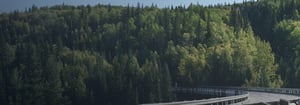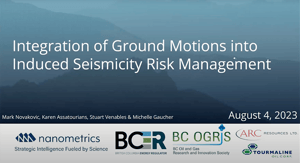In response to the growing significance of induced seismicity in the Kiskatinaw Area of Northeastern British Columbia (NEBC), Nanometrics Inc. spearheaded a research initiative under the project title "Integration of Ground Motions into Induced Seismicity Risk Management in the Kiskatinaw Area, NEBC." The primary objectives of the study were the development of regional ground motion models for induced events, which can be used for the assessment of associated hazard in future, and to review of the existing magnitude thresholds of traffic-light protocols (TLPs) on the basis of ground motions for effective induced seismicity risk management. The study is conducted in three phases, where the first phase sought to develop a ground motion model (GMM) and site amplification map; the second phase investigated literature to define perception and potential damage thresholds in terms of Peak Ground Acceleration (PGA) and Peak Ground Velocity (PGV); and finally review the existing TLP threshold definitions. Through these objectives, the project sought to enhance the efficacy of induced seismicity risk management in the specified region.
GMM Development
A regional ground motion model and site amplification map are developed for the Kiskatinaw area to estimate the resultant ground motions from induced events, which can be used for the assessment of the associated hazard. As part of this study, an earthquake catalogue and ground motion dataset are compiled using a combination of public and private data. Regional source and attenuation attributes, which describe how ground motions scale with magnitude and how their amplitudes decay with distance, are examined using the compiled data. Moment magnitude, stress drop and other source parameters are determined following a displacement spectral fitting approach. In order to provide a more robust estimate of ground motions from significant (moderate magnitude) events where ground motion data is sparse, ground-motion simulations are leveraged. A ground-motion prediction equation (GMPE) is developed through regression analysis of recorded data where the source, path and site effects are parameterized in the model. Uncertainties in the ground-motion estimates are quantified through residual analysis in terms of within-event, between-event and total variability. Finally, a site amplification map is developed for the region by correlating empirical station terms from regression analysis to publicly available geotechnical information such as depth to bedrock, surficial geology and the USGS topographic slope based VS30 estimates. The resultant GMM may be evaluated and combined with the site amplification map to develop shakemaps for events of interest.
Perception and Damage Thresholds
The second phase of this study aims to review the available literature in order to identify ground motion levels associated with the perception level and the level of ground motion in which minor damage may begin to occur. Human perception can depend on what the person is doing at the time (walking, driving, sitting, lying down, etc.), if they are in a building or structure, what materials or design level is it constructed, the duration of the earthquake motions and its frequency content. Perception also ranges from barely noticeable to uncomfortable levels. Damage similarly will largely depend on the construction type of the structure (wood, masonry, concrete, steel, etc.), its design level, and overall robustness. Damage can be further broken down into non-structural and structural damage. Non-structural damage may include damage to finishes, plaster, tiles, or non-load bearing walls. This threshold is typically defined as the level of peak ground motion that is sufficient to cause cracking, chipping, or detachment of these non-structural elements, but without compromising the overall safety of the building, found to occur at Modified Mercalli Intensity (MMI) levels of VI. Structural damage includes damage to the load-bearing elements of a structure, such as beams, columns, walls, and foundations and compromises integrity and safety of the structure, and generally are the result of stronger ground motion intensities, MMI VII, than those associated with non-structural damages. Studies by USACE (1972), Barneich (1985), New (1990), Athanasopoulos & Pelekis (2000), and Bommer et al. (2006) were explored to understand perception thresholds based on different sources, including traffic, blasting, pile-driving, and induced seismicity. Ground Motion Intensity Conversion Equations (GMICE) are utilized to translate MMI into equivalent PGA and PGV ranges for each intensity level. In this study, any damage is considered as unacceptable, so ground motion thresholds are defined conservatively by selecting ground motion levels which are unlikely to cause any damage.
Mitigation Strategies
The magnitude ranges associated with perception levels and the beginning of non-structural damage potential were determined and compared with existing TLP thresholds. With the aim of mitigating the risk of potentially damaging ground motions, critical magnitude maps are generated which show the maximum magnitude of an earthquake at that location is that would be unlikely to exceed the perception or onset of non-structural damage at any location thresholds throughout the region. These maps provide valuable insights for earthquake risk assessment and preparedness.
Conclusion
The study contributed to the characterization of source, path and site effects of ground motions resulting from induced seismicity in the Kiskatinaw region of NEBC. By combining the developed GMM and site amplification map with the ground motion perception and damage thresholds from the literature review, critical earthquake magnitude scenarios are identified which provide guidance for the refinement of TLP levels across the region.
WATCH THE webinar



